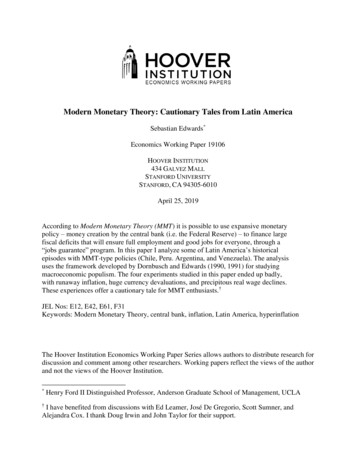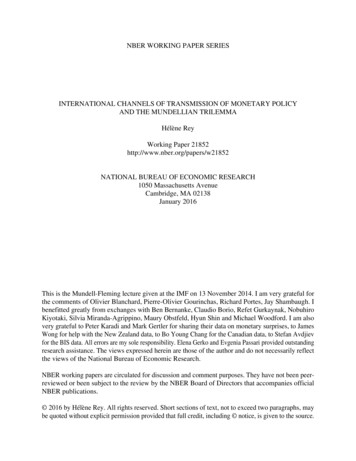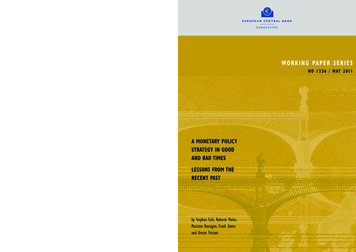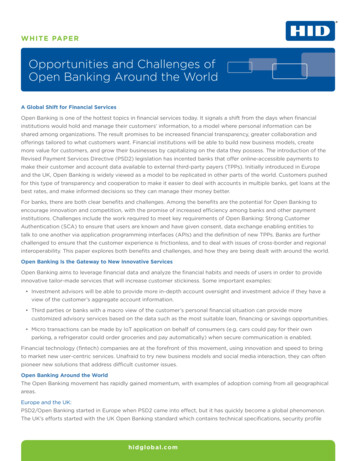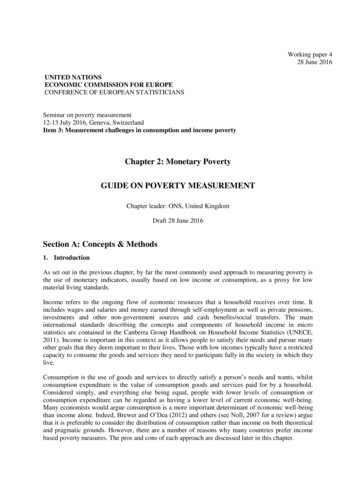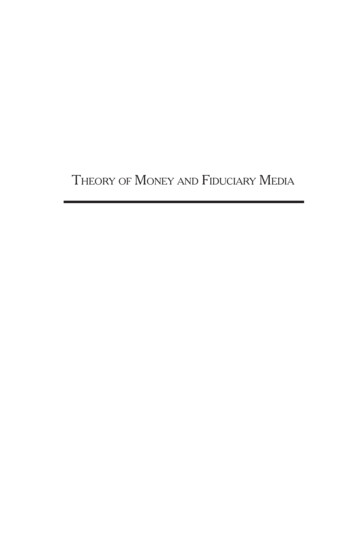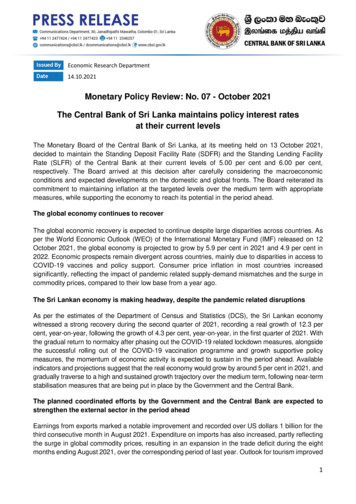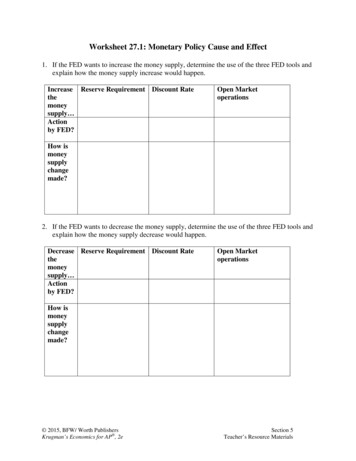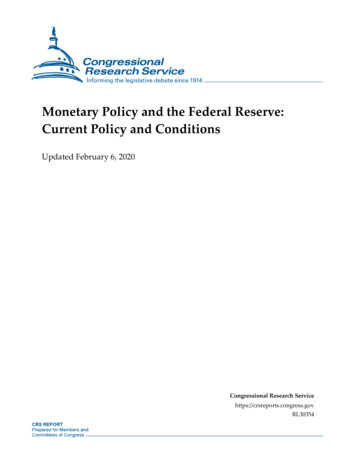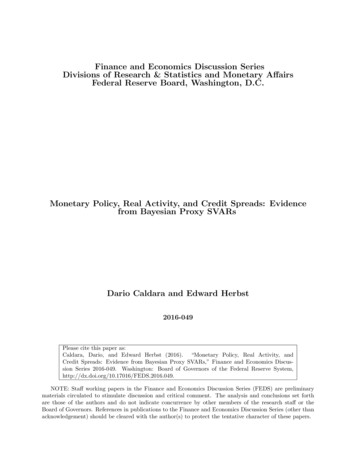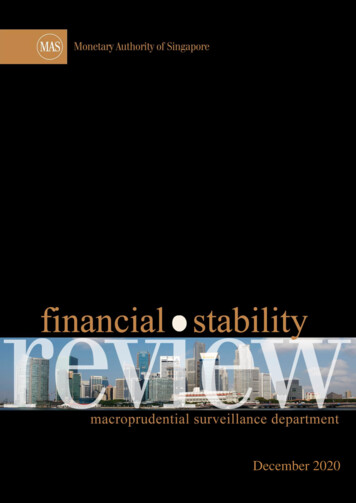
Transcription
December 2020
iFinancial Stability Review December 2020Financial Stability ReviewDecember 2020ISSN 1793-3463Published in December 2020Macroprudential Surveillance DepartmentEconomic Policy GroupMonetary Authority of Singaporehttps://www.mas.gov.sgAll rights reserved. No part of this publication may bereproduced, stored in a retrieval system or transmittedin any form or by any means, electronic, mechanised,photocopying, recording or otherwise, without theprior written permission of the copyright owner exceptin accordance with the provisions of the Copyright Act(Cap. 63). Applications for the copyright owner’s writtenpermission to reproduce any part of this publicationshould be addressed to:Macroprudential Surveillance DepartmentEconomic Policy GroupMonetary Authority of Singapore10 Shenton WayMAS BuildingSingapore 079117
iiContents1PrefaceviiOverviewviiiGlobal Financial and Economic EnvironmentRisks in the External Environment2Singapore Corporate SectorRisks in the Corporate SectorBox A:Chart Panel 2A:3511Singapore’s Corporate Bond Market: A Growing Source ofDomestic Finance21Small and Medium-sized Enterprise Financing Conditions26Singapore Household SectorRisks in the Household Sector4127Singapore Financial SectorRisks in the Banking Sector39Risks in the Non-Bank Sector45Box B:Credit Conditions amid the COVID-19 Pandemic47Box C:MAS’ Desktop Stress Test of D-SIBs53Chart Panel 4A:Banking Sector: Credit Growth Trends58Chart Panel 4B:Banking Sector: Cross-border Lending Trends59Chart Panel 4C:Banking Sector: Asset Quality and Liquidity Indicators60Chart Panel 4D:Banking Sector: Local Banking Groups61Chart Panel 4E:Insurance Sector62Chart Panel 4F:Over-the-counter Derivatives63Special Features on Financial StabilitySpecial Feature 1:Implications of USD Dominance on Capital Flows and FinancialStability in EMEs65Special Feature 2:Transitioning to a New Interest Rate Benchmark Landscape inSingapore73Special Feature 3:Climate Change and Financial Stability80Special Feature 4:S-REITs’ Performance During the COVID-19 Pandemic91
iiiFinancial Stability Review December 2020Statistical appendix may be accessed -stability-reviewDisclaimer: MAS is not liable for any damage or loss of any kind, howsoever caused as a result (direct orindirect) of the use of any information or data contained in this publication, including but not limited toany damage or loss suffered as a result of reliance on the information or data contained in or available inthis publication. You are reminded to observe the terms of use of the MAS website, on which thispublication is made available.
ivDefinitions and conventionsAs used in this report, the term “country” does not in all cases refer to a territorial entity that is a stateas understood by international law and practice. As used here, the term also covers some territorialentities that are not states but for which statistical data are maintained on a separate and independentbasis.In this report, the following groupings are used: “ASEAN-4” comprises Indonesia, Malaysia, the Philippines and Thailand.“Emerging Asia” comprises Asian economies such as China, Hong Kong, India, Indonesia, SouthKorea, Malaysia and Thailand.“EMEA” refers to Europe, Middle East and Africa.“Euro zone” comprises Austria, Belgium, Cyprus, Estonia, Finland, France, Germany, Greece,Ireland, Italy, Latvia, Lithuania, Luxembourg, Malta, Netherlands, Portugal, Slovakia, Sloveniaand Spain.“LATAM” refers to Latin America.Abbreviations used for financial data are as follows: Currencies: Australian Dollar (AUD), British Pound (GBP), Chinese Yuan (CNY), Euro (EUR), HongKong Dollar (HKD), Indian Rupee (INR), Indonesian Rupiah (IDR), Japanese Yen (JPY), KoreanWon (KRW), Malaysian Ringgit (MYR), New Taiwan Dollar (TWD), New Zealand Dollar (NZD),Singapore Dollar (SGD), Thai Baht (THB), US Dollar (USD).Other abbreviations:ABGAsian Bond GrantABSAssociation of Banks in SingaporeABSDAdditional Buyer’s Stamp DutyAEAdvanced EconomyATMAutomated Teller MachineBdFBanque de FranceBISBank for International SettlementsBoEBank of EnglandBTIBalance-to-incomeCARCapital Adequacy RatioCCRCore Central RegionCET1Common Equity Tier 1COVID-19Coronavirus Disease 2019CRECommercial Real EstateDBUDomestic Banking UnitDDRSDepository Trust & Clearing Corporation Data Repository (Singapore) Pte LtdDNBDe Nederlandsche BankDOSDepartment of StatisticsD-SIBDomestic Systemically Important Bank
vFinancial Stability Review December 2020EBITEarnings Before Interest and TaxesECBEuropean Central BankEDBEconomic Development BoardEMEEmerging Market EconomyESGEnterprise SingaporeEUEuropean UnionF&BFood and BeverageFCIFinancial Conditions IndexFIFinancial InstitutionFRAForward Rate AgreementFRNFloating Rate NoteFSBFinancial Stability BoardFSRFinancial Stability ReviewFVIFinancial Vulnerability IndexFXForeign ExchangeGDPGross Domestic ProductGFCGlobal Financial CrisisG-SIBGlobal Systemically Important BankHDBHousing Development BoardHQLAHigh Quality Liquid AssetsIAMIntegrated Assessment ModelICRInterest Coverage RatioIIFInstitute of International FinanceIMFInternational Monetary FundIPIlliquidity PremiumIRInterest RateISDAInternational Swaps and Derivatives AssociationIWSTIndustry-Wide Stress TestJSSJobs Support SchemeLBSLocational Banking StatisticsLCRLiquidity Coverage RatioLIBORLondon Interbank Offered RateLTDLoan-to-DepositLTVLoan-to-ValueMAMatching AdjustmentMASMonetary Authority of SingaporeMOMMinistry of Manpowerm-o-mMonth-on-MonthMSDMacroprudential Surveillance DepartmentMSRMortgage Servicing RatioNDFNon-deliverable ForwardNGFSNetwork of Central Banks and Supervisors for Greening the Financial SystemNFCNon-financial CorporateNIMNet Interest MarginNPANon-Performing AssetNPLNon-Performing Loan
viO&GOil and GasOCROutside of Central RegionOTCOver-the-counterOTPOption to PurchasePRPermanent Residentq-o-qQuarter-on-QuarterRBCRisk Based CapitalRCRRest of Central RegionREITReal Estate Investment TrustRHSRight Hand SideROAReturn on AssetsSAARSeasonally Adjusted Annual RateSBFSingapore Business FederationSC-STSSteering Committee for SOR Transition to SORASFEMCSingapore Foreign Exchange Market CommitteeSFRPSpecial Financial Relief ProgrammeSGXSingapore Exchange LimitedSIBORSingapore Interbank Offered RateSMESmall and Medium-sized EnterpriseSOEState-Owned EnterpriseSOFRSecured Overnight Financing RateSORSGD Swap Offer RateSORASingapore Overnight Rate AverageS-REITSingapore-listed Real Estate Investment TrustTSCTransport, Storage and CommunicationsURAUrban Redevelopment AuthorityVAValue-AddedVARVector autoregressionVIXChicago Board Options Exchange Volatility Indexy-o-yYear-on-YearYTDYear-to-date
viiFinancial Stability Review December 2020PrefaceThe Monetary Authority of Singapore (MAS) conducts regular assessments of Singapore’sfinancial system, which identify potential risks and vulnerabilities, and review the capacity ofthe financial system to withstand potential shocks. The analyses and results are published inthe annual Financial Stability Review (FSR). The FSR aims to contribute to a betterunderstanding of issues affecting Singapore’s financial system among market participants,analysts and the public.Section 1 of the FSR provides a discussion of the risks in the external environment. This isfollowed by an analysis of the Singapore corporate and household sectors in Sections 2 and3 respectively. A review of the financial sector is then provided in Section 4. The final sectionfeatures in-depth analyses on various topics in financial stability.The production of the FSR was coordinated by the Macroprudential Surveillance Department(MSD) team that comprises Lily Chan, Evelyn Chen, Fan Jia Rong, Cheryl Ho, Koh Zhi Xing,Khoo Ye-Min, Kwek Kiat Cong, Wendy Lee, Aloysius Lim, Kalena Lim, Rosemary Lim,Vincent Low, Low Yen Ling, Orchi Modhurima, Satish Nagdev, Ng Heng Tiong, Desmond Ong,Alex Phua, Edward Robinson, Tan Aik Khim, Andrew Tan, Daniel Teo, Teoh Shi-Ying,Andrew Wilfred, and Wong Siang Leng. The FSR also incorporates contributions from Irineude Carvalho Filho, Banking Departments I & II, Corporate Finance & Consumer Department,Capital Markets Intermediaries Department II, Enterprise Knowledge Department, EconomicAnalysis Department, Economic Surveillance & Forecasting Department, Financial MarketsDevelopment Department, Insurance Department,Monetary & Domestic MarketsManagement Department, Prudential Policy Department, Baskar Chinniah, and HarshithaGooty. The FSR reflects the views of the staff of MSD and other contributors.The FSR may be accessed in PDF format on the MAS ial-stability-review
viiiOverviewThe COVID-19 pandemic has raised risks to global financial stability The COVID-19 pandemic led to an unprecedented contraction in economic activity andheightened risks to global financial stability. Decisive monetary and fiscal policy measureshave alleviated near-term risks by easing global financial conditions and maintaining the flowof credit to businesses and households. However, medium-term vulnerabilities have risen asa result of these measures. Corporate leverage has continued to climb from already elevatedlevels, increasing credit risk. Higher sovereign debt levels amid unprecedented fiscal stimulushave also contributed to debt sustainability concerns. Capital flows to emerging marketeconomies (EMEs) remain volatile, suggesting that market sentiment continues to be fragilewith the path of recovery uncertain. A sudden spike in risk aversion could trigger aretrenchment from funds in the non-bank financial sector, causing liquidity stresses infinancial markets. EMEs could be susceptible to a resurgence of capital outflows. While recentprogress in vaccine development could provide some upside to economic growth, much isstill dependent on the effectiveness of the vaccines and their widespread deployment. even as domestic financial conditions remain supportive.Financial conditions in Singapore have eased since tightening in March this year.Domestic factors (including the exchange rate, interest rate as well as equity and propertyprices) have played a key role in keeping overall financial conditions relatively supportive.Corporates, households and the financial sector in Singapore have remainedgenerally resilient so far despite the initial COVID-19 shock.Corporates, households and banks in Singapore have remained resilient following theonset of the COVID-19 pandemic. The corresponding Financial Vulnerability Indices (FVI) forthe respective segments were broadly unchanged on a year-ago basis (see table below).SectorOverall Corporate FVIOverall Household FVIOverall Banking FVIy-o-y Change as ofQ2 20201Q3 2020Q3 2020ChangeThe FVI is calibrated according to deviations from its historical distribution and divided into five coloured bands,which reflect varying degrees of y-o-y change. An increase/decrease in the FVI indicates that vulnerability hasrisen/fallen over the previous year.y-o-y Changes in FVIDecreasedsignificantly1BroadlyUnchangedFor the corporate FVI, the latest available data is as of Q2 2020.Increasedsignificantly
ixFinancial Stability Review December 2020Singapore corporate balance sheets were relatively resilient entering 2020, amid elevatedbut stable debt levels. The COVID-19 pandemic led to a fall in earnings and further rise indebt, worsening leverage risk. However, most firms should be able to withstand short-termpressures on their financial positions. Firms’ liquidity has improved with efforts to bolster theircash buffers, as well as support from the government, MAS and the financial industry to easecashflows and provide continued access to financing. Nonetheless, increased cash holdingshave been accompanied by an increase in short-term debt and maturity risk. Foreign currencyrisk has remained stable as Singapore firms have avoided excessive reliance on foreigncurrency borrowings.Household balance sheets in Singapore were relatively healthy at the onset of theCOVID-19 pandemic owing to financial buffers built up in the preceding years, andhouseholds’ debt servicing burden remains manageable under stress. Government transfersand measures extended by MAS and the financial industry mitigated the impact of a sharp fallin employment and incomes in H1 2020. While growth in overall household debt hasmoderated, leverage risk has edged up, due to a temporary rise in the debt-to-GDP ratio asGDP fell sharply in Q3 2020. Maturity risk has decreased, alongside reduced outstandingunsecured debt.Singapore’s financial sector has also been resilient to the economic and financial impactof COVID-19. The banking sector has experienced some deterioration in credit quality, butstrong capital and liquidity positions provide a robust base for banks to continue supportingthe economy’s demand for credit. Funds in Singapore weathered the market volatility in Marchthis year. Insurers have also remained strong amid the uncertain economic outlook, bolsteredby the enhanced capital framework (RBC 2) that came into effect in March 2020. This reportalso considers the impact of a “low for long” interest rate environment on insurers via a stresstest, and assesses the performance of Singapore-listed Real Estate Investment Trusts (S-REITs)during COVID-19.The economy’s overall credit-to-GDP ratio has increased despite the moderation inresident credit growth. The increase largely reflects the decline in GDP as a result of the sharpeconomic downturn, rather than a significant increase in credit levels. Hence, MAS willmaintain the Countercyclical Capital Buffer (CCyB) at 0%.However, given the uncertain economic outlook, Singapore corporates,households and the financial sector should remain vigilant and prudent.While the economy is expected to pick up next year, its uneven trajectory will impingeon jobs and corporate profits. The risk of financial stresses remains during this protractedrecovery period. Continued vigilance and prudence therefore remain warranted.Within the corporate sector, smaller firms that tend to be financially weaker, and thosein the domestically-oriented and travel-related services impacted by COVID-19 remainvulnerable.
xHouseholds should be prudent in taking up new debt and in committing to propertypurchases as the labour market recovery is expected to be protracted. Whenever possible,they should continue servicing or consolidating their existing obligations to enhance resilienceagainst unexpected shocks.Banks are likely to face challenging operating conditions in the near term. The prolongedlow interest rate environment and asset quality deterioration amid continued uncertainty inthe global outlook will exert pressure on banks’ profitability, even as they continue to maintainstrong underwriting standards and healthy capital buffers. Banks should also continue toactively monitor and manage their foreign currency risks prudently to guard against arenewed tightening of global funding conditions. Similarly, insurers are expected to beimpacted by a prolonged low interest rate environment. They should closely monitor theirsolvency positions and adopt a prudent and forward-looking perspective to capitalmanagement.Macroprudential Surveillance Department, Economic Policy GroupMonetary Authority of Singapore1 December 2020
1Financial Stability Review December 20201Global Financial and EconomicEnvironmentThe COVID-19 pandemic led to an unprecedented contraction in global economicactivity, and heightened stress and risk in the international financial system. In response,authorities took swift and forceful monetary and fiscal measures to support the economy andpreserve financial stability. While the decisive policy response has alleviated near-term risksto financial stability, some of these measures may have also raised medium-termvulnerabilities, alongside expectations of an uneven and uncertain economic recovery.Accommodative financial conditions are necessary to support the economy and stabilisethe financial system. However, they have fuelled rising indebtedness against a backdrop ofalready elevated corporate debt levels and lower levels of activity, increasing credit risk. Fiscaldeficits have also widened as a result of unprecedented government support, raising publicdebt sustainability concerns.With the path of recovery still uncertain, risk sentiment remains fragile and EMEs couldbe susceptible to a resurgence of capital outflows. Policymakers need to balance a delicatetrade-off between supporting economic recovery and managing financial stability risks.The COVID-19 pandemic has severely impacted global growth and raised risksto global financial stability, prompting authorities to provide swift andextensive support.The onset of COVID-19 and the measures to contain its spread triggered a sudden fall inglobal economic activity, presenting significant downside risks to global financial stability.Liquidity stresses abruptly surfaced in the global financial system in March 2020, as worriesabout the economic impact of the pandemic triggered a global flight to safety and a sharprise in short-term demand for safe assets (Charts 1.1 and 1.2). Investor flight away from riskierassets manifested in extreme volatility and a sharp repricing in financial markets (Chart 1.3).Central banks and governments were swift in rolling out policy measures to tackle themarket stress. Central banks provided liquidity to the financial system, through directpurchases of corporate bonds and foreign currency swap lines, to restore the smoothfunctioning of funding markets. Monetary policy was also eased in many major economies,alongside fiscal measures such as government risk-sharing via loan guarantees, whichsupported the flow of credit to the economy. Credit relief measures such as loan moratoriahave also helped to support households and businesses facing cashflow difficulties andtempered the crystallisation of borrower defaults for banks.
Global Financial and Economic Environment2 Chart 1.1 USD liquidity conditions in the UStightened significantly in March 2020 Chart 1.2 leading to a rise in USD funding costsglobally3-month Commercial Paper (CP) vs Overnight IndexedSwap (OIS) SpreadSelected Cross-currency Basis Swaps Financial CP-OISEURSGDNon-financial CP-OIS25010JPYMYRHKDTHB150Basis PointsBasis Points200100500-50-30-70-110Dollar borrowingmore expensive-150JanApr2020JulOct NovJanAprJulOct Nov2020Source: MAS estimates, Board of Governors of the FederalReserve System, DatastreamSource: BloombergChart 1.3 Financial markets experiencedextreme volatility and a sharp repricing inMarch 2020VIX and Equity Price IndicesVIXEquity Price Indices (RHS)Max to Min Range JulOct Nov2020Source: MAS estimates, BloombergNote: Includes S&P 500, Euro STOXX 600, Nikkei 225 andMSCI Emerging Markets indices.Aggressive monetary policy action has led to an easing of financial conditions,alleviating near-term financial stability risks.The loosening of monetary policy across major advanced economies (AEs) hascontributed to a significant easing of global financial conditions since the market turmoil inMarch 2020 (Chart 1.4). Financial conditions in Singapore have also eased in line with globaldevelopments, and on the back of accommodative domestic conditions. Compared to pastcrises, domestic factors that include the exchange rate, interest rate, as well as equity andproperty prices, have played a key role in keeping overall financial conditions relativelysupportive. Within ASEAN, funding conditions have likewise improved (Chart 1.5). Meanwhile,financial conditions in China have remained relatively tighter than usual as policymakers havekept policy rates steady since April, scaling back expectations of further monetary policy
3Financial Stability Review December 2020loosening and leading to a corresponding rise in interbank rates and bond yields. The policyshift came amid broadening economic recovery, allowing policymakers room to focus oncontaining rising financial sector risks and continuing with their medium-term objective ofrestraining the rise in overall banking system leverage.Chart 1.4 Overall financial conditions have easedsignificantly since the tightening early in the yearChart 1.5 Funding conditions in the region haveimproved amid large-scale policy supportGlobal and Domestic Financial Conditions IndicesImplied USD Funding RatesUSOther andard Deviations3IndonesiaPhilippinesEuro zoneEM Asia (ex-China)Singapore1402-10201620172018201920182020 Q3Source: MAS estimates, International Monetary Fund (IMF)20192020NovSource: BloombergThe global banking system confronted the crisis from a position of resilience. Togetherwith governments and central banks’ support measures, these factors have allowed banks tocontinue lending to households and businesses during the pandemic. but fuelling a build-up of vulnerability.While such accommodative financial conditions have alleviated near-term financialstability risks by allowing credit to be more readily available and have likely forestalled evengreater economic damage, they have also contributed to a rise in vulnerability.Accommodative financial conditions, driven by central bank and government supportmeasures, have helped to boost market confidence and, accordingly, financial asset prices.However, policy intervention has widened a disconnect between financial market valuationsand the real economy as risk asset prices have rebounded despite lingering economicuncertainty (Chart 1.6). Any change in market expectations of economic recovery (e.g.premature withdrawal of policy support) could trigger a bout of disruptive adjustment inmarket pricing.Accommodative financial conditions have also contributed to a rise in medium-termvulnerabilities by fuelling greater indebtedness alongside falling corporate and householdincomes. Leverage has increased against a backdrop of already high corporate debt levelsnoted in the last FSR (Chart 1.7). These developments highlight concerns regarding debtsustainability and corresponding credit risk to the financial sector, especially as the globaleconomy now faces an uncertain recovery path.
Global Financial and Economic EnvironmentWithin the region, corporate vulnerabilities have risen sharply over the past year. This ismeasured by an FVI that MAS constructed based on a principal component analysis for theASEAN-42 corporate sector (Chart 1.8). The FVI considers four broad categories of financialvulnerability—leverage, liquidity mismatch, maturity mismatch and foreign currencymismatch, using quarterly data for each vulnerability category.Based on the ASEAN-4 FVI, the rise in vulnerabilities has largely been driven by higherleverage and foreign currency mismatch risks. ASEAN-4 corporates have taken on more debtto meet increased financing needs, leading to growing corporate leverage and a rise in foreigncurrency-denominated bonds. As emerging market currencies are prone to depreciationpressures in a risk-off environment, corporates in such emerging economies could be moresusceptible to foreign currency mismatch risk, especially if their liabilities are largelyunhedged.Chart 1.7 Corporate debt has continued toincrease from elevated levelsSelected Equity Market IndicesNon-financial Corporate Debt as % of GDPAll countriesS&P 500Euro STOXX 600Nikkei 225MSCI Emerging ource: MAS estimates, Datastream201120142017Source: Bank for International Settlements (BIS)Chart 1.8 ASEAN-4 corporate vulnerabilitieshave risen in recent quarters, driven byleverage and foreign currency mismatch risksASEAN-4 FVIsStandard Deviations2LeverageMaturityCorporate FVILiquidityForeign currency10-1-220122014201620182020 Q2Source: MAS estimates, Asian Development Bank (ADB),Bloomberg, Institute of International Finance (IIF), Haver,Worldscope2AE110%Index (1 Jan 2020 100)Chart 1.6 Equity markets have reboundedsince the sharp repricing in MarchASEAN-4 comprises Indonesia, Malaysia, the Philippines and Thailand.2020 Q14
5Financial Stability Review December 2020Further accumulation of corporate debt could increase credit risk, discouragebank lending, and tighten financial conditions.Given the uneven and protracted economic recovery in many jurisdictions and the risk ofrenewed movement controls arising from bouts of epidemic flare-ups, many businesses andhouseholds are likely to continue to grapple with weaker revenue and earnings for some time.As more debt is accumulated, business and household incomes may not catch up with theirincreased servicing costs (for example, in cases of business or job redundancy arising fromCOVID-19), and borrowers could eventually default.The materialisation of this credit risk will increase bank credit losses, and may promptbank capital adequacy and solvency concerns that could weaken their ability and willingnessto lend. Financial conditions may subsequently tighten and hinder the economic recovery.This situation could be further exacerbated in regions where banks had already been facingweak profitability amid a prolonged low interest rate environment.Against these risk factors, large, global systemically important banks (G-SIBs) generallymaintain strong capital positions and thus have more buffers to mitigate the deterioration incredit quality (Chart 1.9).3 Banks in general had also been increasing their loan loss provisionsto buffer against rising credit losses during the initial months of the pandemic. However, theeconomic recovery in Q3 across various jurisdictions might have induced banks to reduce loanprovisioning and added pressure for them to restart dividend payments. Given the uncertaintyover the path of the pandemic, such actions may pose some risk to banks’ future lossabsorbing capacities.Conversely, smaller banks may face greater risk due to relatively higher exposures toriskier segments, for instance through loans to small and medium-sized enterprises (SMEs).SMEs typically have less financial buffers to withstand the short-term cashflow shocks, and aremore likely to encounter loan repayment difficulties. Smaller banks are also likely to have lessgeographically diversified portfolios, and therefore higher concentration risk to movementrestrictions in individual jurisdictions, compared to larger banks.3IMF (October 2020), Global Financial Stability Report.
Global Financial and Economic EnvironmentChart 1.9 Bank capital positions have remained adequate since the outbreak of COVID-19Weighted Average of Common Equity Tier 1 to Risk-weighted Assets Ratio, for G-SIBs and selected economiesQ1 2020Q2 20202520%151050G-SIBsCNUSINJPEUMYUKTHIDSource: MAS estimates, SNL FinancialNote: Capital levels weighted by banks’ share of total risk-weighted assets within each group.Managing continued policy support well will mitigate financial stability risks.Broad-based policy support from governments has helped to stabilise the immediatefinancial position of firms quickly and prevented liquidity pressures from developing intosolvency issues. However, continuing broad-based support including towards unviablecorporates could delay the resource reallocation that needs to take place as well as therecognition of unavoidable credit loss, even as the financial stability risk associated withunsustainable debt rises.Policy support also cannot continue indefinitely, given the increasing strains on fiscalsustainability. Policymakers thus face the challenge of unwinding the support measures in anorderly manner that minimises the risk of a sharp spike in bankruptcies and defaults. Policymissteps from a premature withdrawal of support measures could result in a credit risk “cliffeffect” and widespread defaults, particularly by more vulnerable firms and households. Asbanks recognise a larger amount of loan losses, they may pull back on credit supply. Thiswould forestall the recovery and cause further stress on underlying financial sectorvulnerabilities.Liquidity stresses in the non-bank financial sector are a source of vulnerability.The increased demand for precautionary liquidity placed strains on the non-bankfinancial sector in March this year. While central bank measures have since provided somereprieve, liquidity stresses in the non-bank financial sector remain a source of vulnerability.Central bank policy support to the non-bank financial sector remains largely indirect, workingthrough banking systems or through asset market intervention. The hoarding of liquidity bybanks as well as limits and criteria adopted by asset purchase programmes could reduce theefficacy of these measures. Consequently, adequate support may fail to reach non-bankfinancial institutions in a timely manner should risk aversion and liquidity stresses return.6
7Financial Stability Review December 2020Sovereign debt as a percentage of GDP increased, raising public debtsustainability concerns.The unprecedented fiscal stimulus that governments have rolled out to mitigate theimpact of COVID-19 (Chart 1.10) coupled with a reduction in tax revenues has caused fiscaldeficits to widen globally in 2020. 4 Together with the economic contraction caused byCOVID-19, sovereign debt as a percentage of GDP rose and could continue to do so shouldfurther fiscal support be deemed necessary (Chart 1.11).Chart 1.10 Fiscal stimuli in response to theCOVID-19 shock have been large across AEs andEMEs Chart 1.11 leading to higher public debt as apercentage of GDPSize of Fiscal Response to COVID-19 as % of GDPGross Public Debt as % of GDPAEsEM Asia12160AEsAEs (projected)EM AsiaEMEs (projected)120%%88044000USSource: IMFJPUK TH CN EUIDPHIN2010201520202025Source: IMFAccommodative monetary policy and asset purchase programmes by central banks sincethe onset of the COVID-19 shock have brought down the cost of borrowing and hel
risk has remained stable as Singapore firms have avoided excessive reliance on foreign currency borrowings. Household balance sheets in Singapore were relatively healthy at the onset of the COVID-19 pandemic owing to financial buffers built up in the preceding years, and

